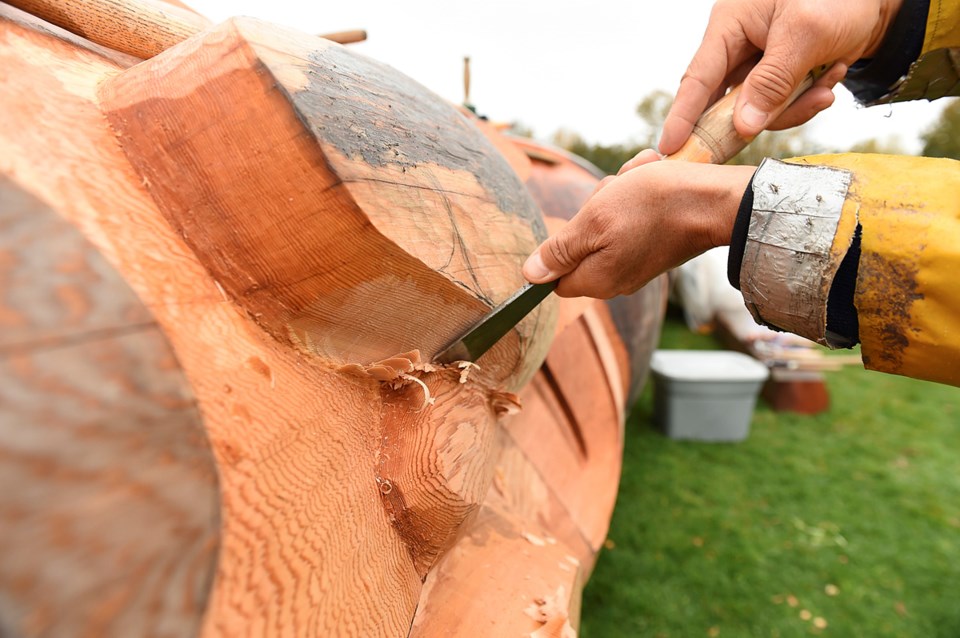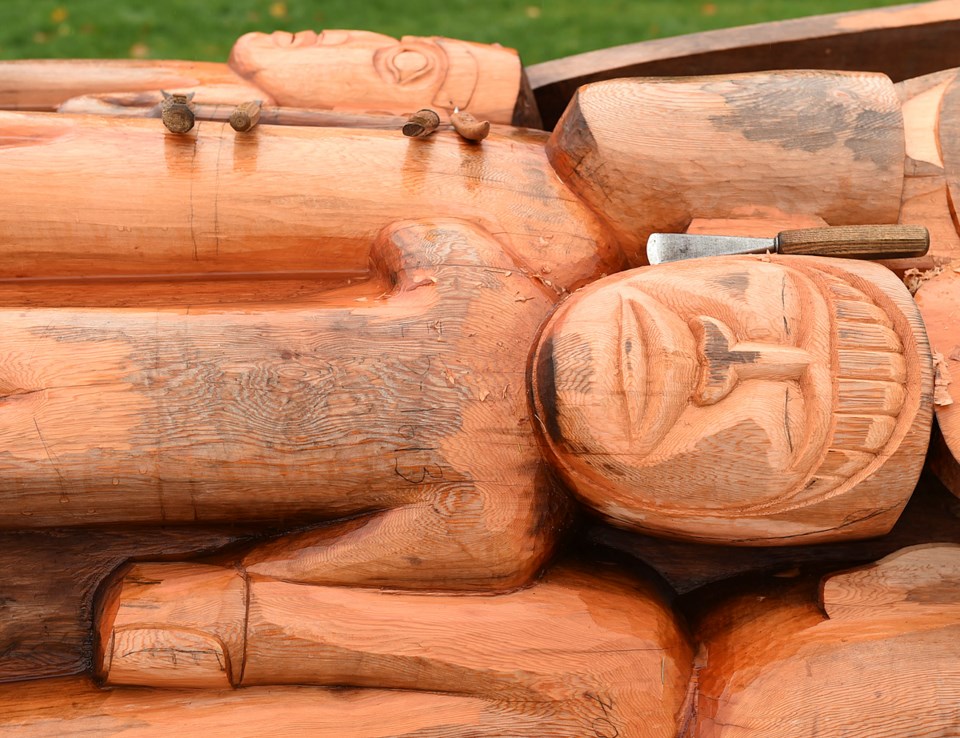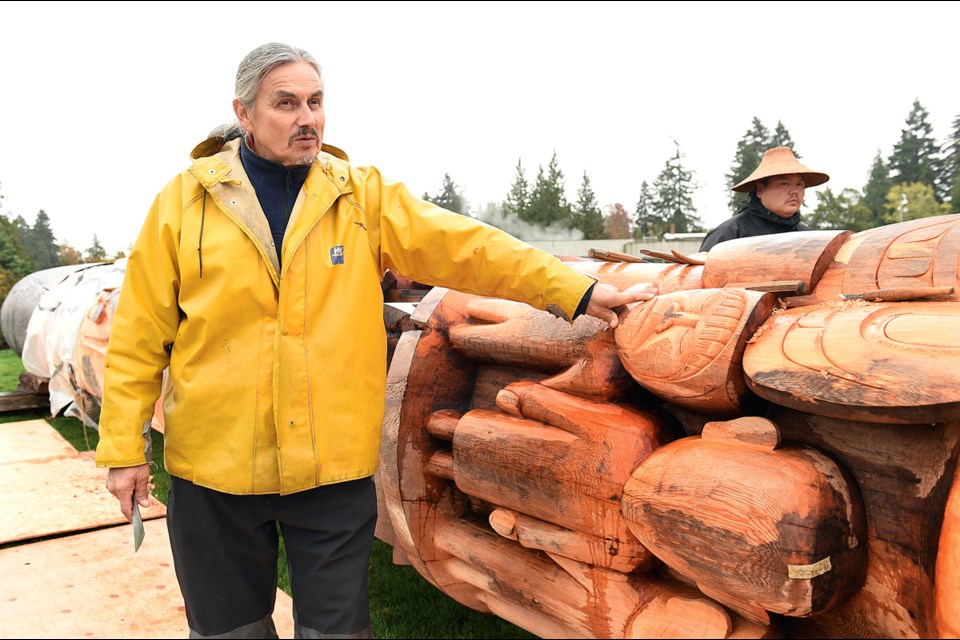The story that Haida artist James Hart is telling is done with wood carving tools.
It’s a difficult story to tell for a man who has grown up in a community that has lost so much.
But what Hart has carved and shaped on the massive 800-year-old red cedar log lying before him is nothing short of a masterful work of storytelling: it is emotional, courageous and hopeful. From tip to tip, Hart has captured a history, a present and a future that is easily and painfully understood when he walks the length of the 67-foot log to explain his design.
“It was tough — the subject was tough,” said the 64-year-old Hart, as he stood in the rain Monday on the grounds near the Museum of Anthropology at the University of B.C., where he is getting close to finishing what will be named the “reconciliation pole.”

The commissioning of the totem is the result of a partnership between arts philanthropist Michael Audain and the university. The pole, which weighs 26,000 pounds and arrived on a barge from Haida Gwaii earlier this month, is expected to be raised sometime in the spring near the Beaty Biodiversity Museum on campus.
Hart begins his story near the centre of the pole, where he has carved a haunting looking residential school into darkened wood. It’s modelled after the Coqualeetza residential school in Sardis, B.C., where Hart’s grandfather and other relatives attended as children. Hart never went to residential school.
“I grew up with all these stories from that time of when they went to these schools,” he said, noting some of the stories he heard were from former students responsible for burying the bodies of classmates who died at school.
Truth and Reconciliation Commission of Canada estimated more than 6,000 children died at residential schools between the 1840s and 1996, although other estimates in indigenous communities have suggested thousands more perished. Some 150,000 children from across Canada attended the church-run, government-funded schools, which were designed to have indigenous children assimilate into mainstream Canadian society.
The school is the focal point of Hart’s pole and specifically carved in a place on the log to “look like it was plunked on our heads.” Below the school, Hart carved what life represented for the Haida before children were taken from villages: a mother bear and her cubs, a shaman performing a ritual to ensure the return of the salmon and a raven, which the Haida believe is responsible for the sun, moon and stars, and giving humans fresh water, salmon and fire.
Above the school are carvings of 10 children, all of whom are given an identity number — as was the practice by government at the time — that will be carved into their torsos. Most of the faces have not been carved because Hart is working with indigenous artists from across the country to have them best represent the children of their villages. An 11th child, which Hart has carved lying down, is tucked in behind the pole and represents the children who died in the schools.

Hart also plans to incorporate more than 50,000 copper nails into the design and will likely rely on children — indigenous and non-native — to participate in hammering the nails into the totem. The nails also represent the children.
Above the carvings of the children are shapes of a large killer whale, thunderbird, bear and eagle, which represent land, air, water and the supernatural. The figures are also regarded as guardians of the children. As Hart gets further up the pole, he has carved a mother and father, with faces of children between them.
“It’s the family unit today getting strong again,” he said.
That hopefulness grows above the depiction of family, with plans to bolt a long boat and canoe near the top of the totem. The boats, which represent the coming and working together of indigenous and non-indigenous people, were carved by Hart’s late son, Carl, who died last year at the age of 26. The subject matter of the pole coupled with the loss of his son has meant for an emotional time for Hart.
“I thought about my son all the way through this, every day I thought of him,” said Hart, whose other son, Gwalaga, continues to help with the totem. “It was wonderful to have those years with [Carl]. He was a wonderful young guy. We carried on, and it wasn’t easy.”
A massive #Haida post just rolled down the street. So impressive, smells great in the rain. #UBC pic.twitter.com/g3oQ6zlhST
— Mark Atomos Pilon (@Atomos) October 14, 2016
The very top of the totem will also have some of his late son’s touches. An eagle, which Hart carved with Carl, will be bolted to the top. The eagle is carved in such a way to capture the moment before it takes off.
“And that’s our future,” said Hart, before summing up the story behind the pole. “So if you point your finger anywhere along here, you could write a thesis on it. There’s a lot there to talk about.”
mhowell@vancourier.com
@Howellings


